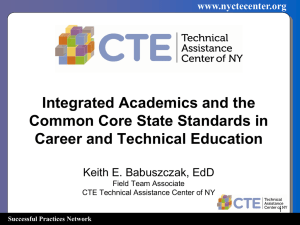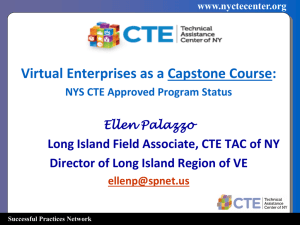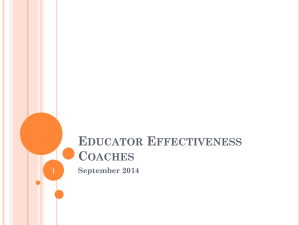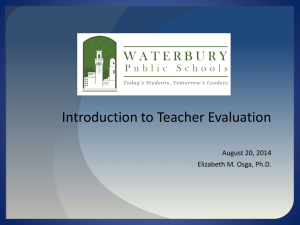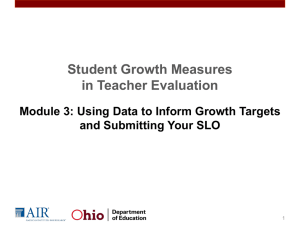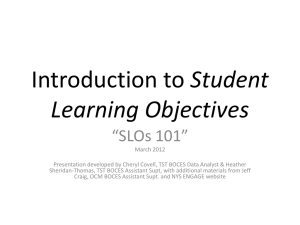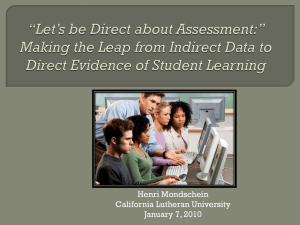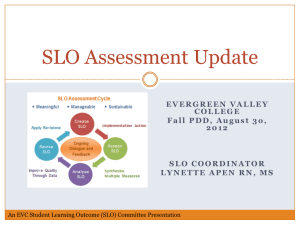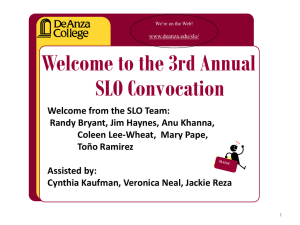APPR SLO Update FACS - CTE Technical Assistance Center of
advertisement
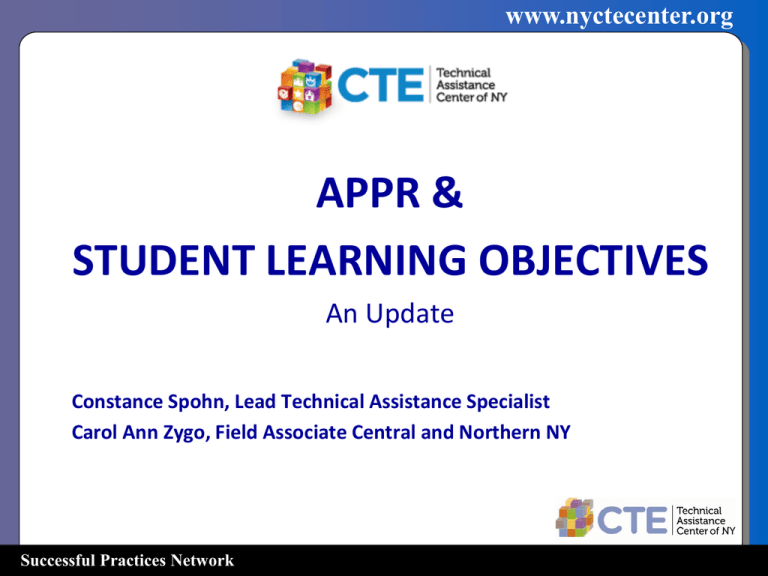
www.nyctecenter.org APPR & STUDENT LEARNING OBJECTIVES An Update Constance Spohn, Lead Technical Assistance Specialist Carol Ann Zygo, Field Associate Central and Northern NY Successful Practices Network www.nyctecenter.org Presenter Dr. Constance Spohn, Lead Technical Assistance Specialist • • • • • • • • • • • CTE Technical Assistance Center Successful Practices Network (current) Retired (2 weeks) Interim Elementary Principal, Fonda-Fultonville CSD Director of Special Programs, Fonda-Fultonville CSD (8 yrs) Online Instructor, VTP SUNY Oswego (current) Coordinator Montgomery Co. 21st CCLC (2 yrs) Director, Two Year College Development Center, Univ. @ Albany(5yrs) Greater Capital District Tech Prep Consortium Coordinator (9 yrs) Professor, Early Childhood, SUNY Cobleskill (10 yrs) Instructor; Early Childhood, Foods, Clothing Services, Madison Oneida BOCES (7 yrs) 2 Successful Practices Network www.nyctecenter.org Presenter Carol Zygo, Field Team Associate NYS CTE Technical Assistance Center • • • • • CTE Technical Assistance Center (current) Successful Practices Network (current) Superintendent, Herkimer CSD (6 years) Principal, Oriskany CSD (10 years) Model Schools Coordinator, Madison-Oneida BOCES (3 years) • Business Teacher (17 years) • College Instructor (Utica College) Successful Practices Network www.nyctecenter.org CTE TAC Background & Purpose State Contract to assist SED in carrying out its mission of improving the quality, access, and delivery of CTE through research-based methods and strategies resulting in broader CTE opportunities for all students. 4 Successful Practices Network www.nyctecenter.org CTE TAC Work Plan 1. Improve CTE data collection to create an accurate picture of career and technical education program performance 2. Assist schools in the integration of the new national common core state standards with CTE. 3. Expand CTE program approvals. 4. Use best practices in CTE for high school improvement. 5. Expand CTE programs and student leadership participation 6. Build relationships and networks to strengthen CTE. 5 Successful Practices Network www.nyctecenter.org 6 Successful Practices Network www.nyctecenter.org The Challenges • Common Core State Standards (CCSS) • Next Generation Assessments (NGA) • Teacher Evaluation Based on Student Performance • Principal Evaluation Based on Student Performance • Prepare Students for the World Beyond School Successful Practices Network www.nyctecenter.org Animating the Reform Agenda Investing in human capital, supporting with critical tools Highly Effective School Leaders Highly Effective Teachers Successful Practices Network College and Career Ready Students Adopting internationallybenchmarked standards and assessments that prepare students for success in college and the workplace (Common Core) Building instructional data systems that measure student success and inform teachers and principals how they can improve their practice (DDI) Recruiting, developing, retaining, and rewarding effective teachers and principals (APPR) Turning around the lowestachieving schools 2 www.nyctecenter.org Animating the Reform Agenda Investing in human capital, supporting with critical tools Teacher Evaluation Components Highly Effective School Leaders Measures of Growth (20%) Grades 4-8 ELA Math LocallyOther selected Measures measures of (60%) student achievement (20%) All Other Successful Practices Network Highly Effective Teachers College and Career Ready Students 3 www.nyctecenter.org Standard 4: Learning Environment New York State Teaching Standards And Elements 4.1 Creates a mutually respectful, safe, and supportive learning environment that is inclusive of every student 4.2 Creates an intellectually challenging and stimulating learning environment 4.3 Manages the learning environment for the effective operation of the classroom 4.4 Organize and utilize available resources [e.g. physical space, time, people, technology] to create a safe and productive learning environment Standard 1: Knowledge of Students & Student Learning Standard 5: Assessment for Student Learning Standard 2: Knowledge of Content and Instructional Planning Standard 6: Professional Responsibilities and Collaboration Standard 3: Instructional Practice Standard 7: Professional Growth 1.1 Knowledge of child and adolescent development, including students’ cognitive, language, social, emotional, and physical developmental levels 1.2 Knowledge of current, research‐based knowledge of learning and language acquisition theories and processes 1.3 Knowledge of and responsive to diverse learning needs, interests, and experiences of all students 1.4 Knowledge of individual students from students, families, guardians, and/or caregivers to enhance student learning 1.5 Knowledge of and responsive to the economic, social, cultural, linguistic, family, and community factors that influences their students’ learning 1.6 Knowledge and understanding of technological and information literacy and how they affect student learning 2.1 Knowledge of the content they teach, including relationships among central concepts, tools of inquiry, and structures and current developments within their discipline[s] 2.2 Teachers understand how to connect concepts across disciplines and engage learners in critical and innovative thinking and collaborative problem solving related to real world contexts 2.3 Uses a broad range of instructional strategies to make subject matter accessible 2.4 Establishes goals and expectations for all students that are aligned with learning standards and allow for multiple pathways to achievement 2.5 Designs relevant instruction that connects students’ prior understanding and experiences to new knowledge 2.6 Evaluate and utilize curricular materials and other appropriate resources to promote student success in meeting learning goals 3.1 Uses research‐based practices and evidence of student learning to provide developmentally appropriate and standards‐driven instruction that motivates and engages students in learning 3.2 Communicate clearly and accurately with students to maximize their understanding and learning 3.3 Set high expectations and create challenging learning experiences for students 3.4 Explores and uses a variety of instructional approaches, resources, and technologies to meet diverse learning needs, engage students and promote achievement 3.5 Engage students in the development of multi‐disciplinary skills, such as communication, collaboration, critical thinking, and use of technology 3.6 Monitors and assesses student progress, seeks and provides feedback, and adapts instruction to student needs 5.1 Design, adapt, select, and use a range of assessment tools and processes to measure and document student learning and growth 5.2 Understand, analyze, interpret, and use assessment data to monitor student progress and to plan and differentiate instruction 5.3 Communicate information about various components of the assessment system 5.4 Reflect upon and evaluate the effectiveness of their comprehensive assessment system to adjust assessment and plan instruction accordingly 5.5 Prepare students to understand the format and directions of assessment used and the criteria by which the students will be evaluated 6.1 Upholds professional standards of practice and policy as related to students’ rights and teachers’ responsibilities 6.2 Engage and collaborate with colleagues and the community to develop and sustain a common culture that supports high expectations for student learning 6.3 Communicate and collaborate with families, guardians, and caregivers to enhance student development and success 6.4 Manage and perform non‐instructional duties in accordance with school district guidelines or other applicable expectations 6.5 Understand and comply with relevant laws and policies as related to students’ rights and teachers’ responsibilities 7.1 Reflect on their practice to improve instructional effectiveness and guide professional growth 7.2 Set goals for and engage in ongoing professional development needed to continuously improve teaching competencies 7.3 Communicate and collaborate with students, colleagues, other professionals, and the community to improve practice 7.4 Remain current in their knowledge of content and pedagogy by utilizing professional resources 10 Successful Practices Network www.nyctecenter.org RUBRICS • Rubric for the Rubrics – Cognitive Engagement – Constructivist learning – 21st Century Skills • NYS Teaching Standards and Elements 11 Successful Practices Network www.nyctecenter.org Table Talk Individually or in groups of two, read one of the 7 teaching standards (including all elements). Identify the type “evidence” you would have to show that you are meeting this standard. Share with your table. Successful Practices Network www.nyctecenter.org Levels of Performance (HEDI) • Highly Effective - Classroom functions as a community of learners with student assumption of responsibility for learning • Effective - Teaching shows evidence of thorough knowledge of all aspects of the profession. Students are engaged in learning. This is successful, accomplished, professional, and effective teaching Successful Practices Network www.nyctecenter.org Levels of Performance (HEDI) • Developing - Teaching shows evidence of knowledge and skills related to teaching—but inconsistent performance • Ineffective - Teaching shows evidence of not understanding the concepts underlining the component-may represent practice that is harmful-requires intervention 14 Successful Practices Network www.nyctecenter.org Composite Score Rating System The agreement significantly tightens the scoring system to ensure student achievement and teacher performance are both properly taken into account for teacher ratings. Teachers or principals that are rated ineffective in the 40 points could not receive a developing score overall. • • • • Ineffective: 0 – 64 Developing: 65 – 74 Effective: 75 – 90 Highly Effective: 91 – 100 Successful Practices Network www.nyctecenter.org Summary of APPR Components Growth State-provided Growth/VA Locally Selected Measures Other Measures Scoring Implementation Successful Practices Network Student Learning Objectives Assessments and Measures • Rubrics • Sources of evidence: observations, visits, surveys, etc (20% 25%) (20% 15%) (60%) Subcomponents, Composite Scores, Ratings Improvement Plans, Appeals, Training 16 www.nyctecenter.org 5 District Decisions (recommended by 5/31/2012) 1. 2. 3. 4. 5. Assess and identify district priorities and academic needs. Identify who will have State-provided growth measures and who must have SLOs as “comparable growth measures.” Determine district rules for how specific SLOs will get set. Establish expectations for scoring SLOs and for determining teacher ratings for the growth component. Determine district-wide processes for setting, reviewing, and assessing SLOs in schools. 3/01 4/16 5/31 . Successful Practices Network 17 www.nyctecenter.org DECISION 1: ASSESS AND IDENTIFY DISTRICT PRIORITIES AND NEEDS Successful Practices Network www.engageNY.org www.nyctecenter.org Step 1. District Leaders Assess and Identify Priorities and Needs • What are the District’s overall priorities, needs, and long-term goals? • HINT: refer to your district strategic plans, and ensure alignment to the Common Core. • HINT: remember that principals and teachers will be held accountable to goals aligned with the district’s stated priorities. • HINT: the more prescriptive district level goals are, the less variation you will see in (content and rigor of) school/classroom goals. Successful Practices Network 19 www.nyctecenter.org DECISION 2: WHO NEEDS AN SLO FOR GROWTH MEASUREMENT? Successful Practices Network www.engageNY.org www.nyctecenter.org Student Learning Objectives per Ed. Law 3012-C Student Learning Objectives (SLOs). Per Education Law 3012-c, 40 percent of teacher and principal evaluations must be based on student achievement. This 40 percent is broken down into two components for 2011-12: 20 percent on student growth on State assessments or comparable measure, and 20 percent on other locally-selected measures. For teachers where there is no State-provided measure of student growth, comparable measures must be used. Under the Regulations, this is referred to as the State-determined growth goal setting process. Student Learning Objectives (SLOs) are the State-determined process. Training courses must provide training on a student growth percentile model and value-added growth model, and for teachers where there is no Stateprovided measure of student growth available, training must be provided on comparable measures of growth which are Student Learning Objectives (SLOs). Training courses must also provide training on the application and use of any State-approved locally selected measures of student achievement: SLOs are a State-approved locally selected measure. Successful Practices Network www.nyctecenter.org What Are Student Learning Objectives (SLOs)? Represents the most important learning for the year (or, semester, where applicable). Based on available prior student learning data. A Student Learning Objective (SLO) is an academic goal set for students at the start of a course. Specific and measurable. Successful Practices Network Aligned to Common Core, State, or national standards, as well as any other district and school priorities. 22 www.nyctecenter.org Required SLOs: Reference Guide Please see the “Required SLOs: Reference Guide” for NYSED’s rules for teachers who have SLOs for State Growth Successful Practices Network 23 www.nyctecenter.org SLO Resources from NYSED Please visit: http://engageny.org/resource/ student-learning-objectives/ Successful Practices Network 24 www.nyctecenter.org SLOs Focus Attention on Essential Learning, Data, and Outcomes What is the aggregate of what my students will learn this year? May/June March/April January/February November/December September/October Successful Practices Network www.nyctecenter.org State Provided Growth Measure or SLOs? Teacher 5th Grade Common Branch Teacher State Provided Growth Measure or SLO? State Provided Growth SGP/VA 8th Grade ELA Teacher State Provided Growth SGP/VA Elementary Art Teacher - Two 2nd grade Art sections with 20 students each; - Two 4th grade Art sections with 25 students each; - One 5th grade Art section with 30 students. SLO: • 1 SLO for 2nd grade Art sections • 1 SLO for 4th grade Art sections 7th Grade Math and Science Teacher - Two 7th grade Math sections with 30 students each; - Two 7th grade Science sections with 25 students each; - One Advanced 7th grade Science section with 20 students. SLO: • 1 SLO for 7th grade math (will receive State provided growth SGP) • 1 SLO for 7th grade Science High School CTE Teacher Culinary I (AM): 28 students Culinary II (PM): 24 student SLO: • 1 SLO for Culinary I section 8th Grade Science Teacher - One 8th grade Science sections with 30 students; - Four 8th grade Advanced Science section with 28 Successful Practices students each. Network SLO: • 1 SLO for 8th grade Advanced Science sections 26 www.nyctecenter.org What SLOs will you need? • Over 50% rule (51+%) • Take time to determine what SLOs you will need to prepare for. Successful Practices Network www.nyctecenter.org NYSED SLO Framework All SLOs MUST include the following basic components: Student Population Which students are being addressed? Learning Content What is being taught? CCSS/National/State standards? Will this goal apply to all standards applicable to a course or just to specific priority standards? Interval of Instructional Time What is the instructional period covered (if not a year, rationale for semester/quarter/etc)? Evidence What assessment(s) or student work product(s) will be used to measure this goal? Baseline What is the starting level of learning for students covered by this SLO? Target(s) What is the expected outcome (target) by the end of the instructional period? HEDI Criteria How will evaluators determine what range of student performance “meets” the goal (effective) versus “well-below” (ineffective) , “below” (developing), and “well-above” (highly effective)? Rationale Why choose this learning content, evidence and target? Successful Practices Network 28 www.nyctecenter.org DECISION 3: HOW WILL SLOs GET SET? Successful Practices Network www.engageNY.org www.nyctecenter.org NYSED SLO Framework A student learning objective is an academic goal for a teacher’s students that is set at the start of a course. • It represents the most important learning for the year (or, semester, where applicable). • It must be specific and measurable, based on available prior student learning data, and aligned to Common Core, State, or national standards, as well as any other school and district priorities. • Teachers’ scores are based upon the degree to which their goals were attained. • Source: Page 4 of Guidance on the New York State District-Wide Growth Goal Setting Process: Student Learning Objectives Successful Practices Network 30 www.nyctecenter.org Student Population These are the students included in the SLO. • Provide course sections in the SLO • Includes all students in the selected course sections • Provides student names and or ID numbers for all students in the selected courses. (Roster) Successful Practices Network 31 www.nyctecenter.org Learning Content This is the content to be taught in the SLO. Identify the course name and source of standards (Common Core, national, state, local) associated with this SLO, and specify the exact standards, performance indicators, etc., that will be taught, learned, and assessed. Successful Practices Network 32 www.nyctecenter.org Learning Content – Continued • Course: • Standards Source: 7th Grade Visual Arts New York State Learning Standards • Standard 1 – Creating, Performing, and Participating in the Arts • Standard 3 – Responding to and Analyzing Works of Art. • Standard 4 – Understanding the Cultural Dimensions and Contributions of the Arts • Performance Indicators: 1c, 1d, 3a, 3c, 4c • Common Core Writing Standards for Literacy in …Technical Subjects: WHST.6-8.4, WHST.6-8.8 Successful Practices Network 33 www.nyctecenter.org Learning Content – Continued (1c) [Students] use the elements and principles of art to communicate specific meanings to others in their art work. (1d) During the creative process [students ] reflect on the effectiveness of selected mediums or techniques to convey intended meanings. (3a) [Students] discuss and write their analyses and interpretations of their own works of art and the art of others, using appropriate critical language. (3c) [Students] compare the ways ideas and concepts are communicated through visual art with the various ways that those ideas and concepts are manifested in other art forms. Successful Practices Network 34 www.nyctecenter.org Learning Content – Continued • (4c) [Students] create art works that reflect a particular historical period of a culture. • (WHST.6-8.4) [Students] produce clear and coherent writing in which the development, organization, and style are appropriate to task, purpose, and audience. • (WHST.6-8.8) [Students] gather relevant information from multiple print and digital sources, using search terms effectively; assess the credibility and accuracy of each source; and quote or paraphrase the data and conclusions of others while avoiding plagiarism and following a standard format for citation. Successful Practices Network 35 www.nyctecenter.org Interval of Instructional Time This is the timeframe within which the learning content will be taught. (This is generally one academic year, unless the course is set as a semester, quarter, etc.) Specify when the teaching for this learning content will begin and end. (Rationale is required if less than the typical year-long interval is set.) • Indicates a clear start and end date. • Provides a rationale if the interval is less than one year (e.g., course length is less than one year). Successful Practices Network 36 www.nyctecenter.org Identify Course In the template provided, identify the course you will work on, resources for identifying standards, interval of instructional time. In the section called “Rationale,” describe your reason for the choices you made. Successful Practices Network www.nyctecenter.org Evidence These are the assessments used for determining students’ levels of learning. Successful Practices Network 38 www.nyctecenter.org Evidence • Identifies pre-assessment(s) and summative assessment(s). • Selects summative assessments from either the State-approved list or those developed and approved by the district/BOCES, and supported by superintendent’s certification of rigor and comparability. • Offers accommodations as legally required and appropriate. • Ensures that those with vested interest are not scoring summative assessments. Successful Practices Network 39 www.nyctecenter.org Evidence – (Summative Rubric) Note on Rubric: Each student’s work will be scored by two other district middle school visual arts teachers using the following rubric, with both teachers’ scores being averaged to yield the final student scores. 2 points 1 point (0 points for no attempt) 3 or more elements 2 elements used that used that strongly reflect strongly reflect stated stated viewpoint viewpoint 1 element was used that strongly reflects stated viewpoint Attempt(s) made, but no elements were used that strongly reflect stated viewpoint 3 or more principles 2 principles used that used that strongly reflect strongly reflect stated stated viewpoint viewpoint 1 principle used that strongly reflects stated viewpoint Attempt(s) made, but no principles were used that strongly reflect stated viewpoint Student does both of the following for three sources: describes generally why sources are credible and accurate cites sources generally and/or clearly following appropriate conventions Attempt(s) made, but one or neither of the following takes place: describes generally why sources are credible and accurate cites sources generally and/or clearly following appropriate conventions 4 points Creative Task (1c) Use of elements (row score x 3) Creative Task (1c) Use of principles (row score x 3) Student does both of the Task 2 following for three (WHST.6-8.8) sources: Gather describes relevant convincingly why source sources are credible information and accurate (row score x cites sources clearly 1) following appropriate conventions Successful Practices Network 3 points Student does both of the following for three sources: describes convincingly why sources are credible and accurate cites sources generally following appropriate conventions 40 www.nyctecenter.org Evidence • Spend some time discussing what evidence or assessments you may have available for this SLO. What will you need? Successful Practices Network www.nyctecenter.org Baseline This is the level of students’ knowledge and skill in the targeted learning content at the beginning of the interval of instructional time. • Describe how students performed on the identified preassessment(s) for the learning content, including any additional data that informed SLO development. • Actual baseline scores for each student are required. Successful Practices Network 42 www.nyctecenter.org Target(s) This is the numeric achievement goal which articulates the amount that students will have to grow during the interval of instructional time. Define numeric growth goals for student performance on identified summative assessment(s) which measure student knowledge and skill in the learning content. (Actual final scores for each student are required.) Successful Practices Network 43 www.nyctecenter.org Target(s) • Provides a target statement. • Provides a specific growth goal for each student. • Sets targets consistent with district-level expectations for target-setting in this grade/subject. Successful Practices Network 44 www.nyctecenter.org Student Population, Baseline, and Target(s) SLO Target Approach 1: Set a common growth target. • 90% of students, including special populations, will grow by 60 percentage points or more on their summative assessment compared to their pre-test for the standards. (e.g., Student E’s target is 60 more than 30, or 90.) Student Pre-Test Score Summative Target Student A 10 70 Student B 20 80 Student C 5 65 Student D 0 60 Student E 30 90 Student F 10 70 Successful Practices Network 45 www.nyctecenter.org Student Population, Baseline, and Target(s) SLO Target Approach 2: Set a growth to mastery target. • 85% of students, including special populations, will grow to score 75% or higher on the summative assessment for the selected standards. Student Student A Pre-Test Score 10 Summative Target 75 Student B Student C Student D 20 5 0 75 75 75 Student E Student F 30 10 75 75 Successful Practices Network 46 www.nyctecenter.org Student Population, Baseline, and Target(s) SLO Target Approach 3: Set differentiated growth targets by student. • 85% of students, including special populations, will meet or exceed their individualized target. Student Student A Student B Pre-Test Score 10 20 Summative Target 80 80 Student C Student D Student E 5 0 30 75 70 85 Student F 10 80 Successful Practices Network 47 www.nyctecenter.org HEDI for SLOs in State Growth What are “district goals” if there is no state test for the grade/subject? Standards for Rating Categories Highly Effective Growth or Comparable Measures Results are well-above state average for similar students (or District goals if no state test). Effective Results meet state average for similar students (or District goals if no state test). Developing Results are below state average for similar students (or District goals if no state test). Ineffective Results are well-below state average for similar students (or District goals if no state test). Successful Practices Network 48 www.nyctecenter.org HEDI • Categorizes all possible scoring results in the HEDI structure such that – Highly effective = exceeds district expectations – Effective = meets district expectations – Developing = is below district expectations – Ineffective = is well below district expectations • Is mathematically possible for the teacher to obtain every point value within a rating category. • Allocates points clearly and objectively within a HEDI rating category. Successful Practices Network 49 Review www.nyctecenter.org Training SLO Target Approach 1: Set a common growth target. 90% of students will grow by 60 percentage points or more on their post-test compared to their pre-test for the standards. (e.g., Student E’s target is 60 more than 30, or 90.) Student Student A Student B Pre-Test Score 10 20 Summative Target 70 80 Student C Student D Student E 5 0 30 65 60 90 Student F 10 70 Successful Practices Network 50 www.nyctecenter.org Training SLO HEDI Approach 1: Set ratings using the percent of students meeting individual targets. 90% of students will grow by 60 percentage points or more on their summative assessment compared to their pre-test for the standards. Highly Effective* (18-20 points) Effective* (9-17 points) Developing* (3-8 points) Ineffective* (0-2 points) 95-100% of students grew by 60 points or more on the standards addressed 86-94% of students grew by 60 points or more on the standards addressed 80-85% of students grew by 60 points or more on the standards addressed 79% or less of students grew by 60 points or more on the standards addressed 85=8 points 84=7 points 83=6 points 82=5 points 80=4 points 80=3 points 70-79=2 points 60-69=1 point 0-59=0 points 98-100=20 points 96-97=19 points 95=18 points 94=17 points 93=16 points 92=15 points 91=14 points 90=13 points 89=12 points 88=11 points 87=10 points 86=9 points Successful Practices Network 51 Review www.nyctecenter.org Training SLO Target Approach 2: Set a growth to mastery target. 85% of students, including special populations, will grow to score 75% or higher on the summative assessment for the selected standards. Student Student A Student B Pre-Test Score 10 20 Summative Target 75 75 Student C Student D Student E 5 0 30 75 75 75 Student F 10 75 Successful Practices Network 52 www.nyctecenter.org Training SLO HEDI Approach 2: Set ratings using the percent of students meeting a collective target (e.g., 80% mastery). 85% of students, including special populations, will grow to score 75% or higher on the summative assessment for the selected standards. Highly Effective* (18-20 points) 91-100% of students demonstrate mastery of 75% of the selected visual arts standards using the postassessment rubric 98-100=20 points 95-97=19 points 91-94=18 points Effective* (9-17 points) Developing* (3-8 points) Ineffective* (0-2 points) 85% -90% of students demonstrate mastery of 75% of the selected visual arts standards using the post-assessment rubric 90=17 points 89=16 points 88=14-15 points 87=12-13 points 86=10-11 points 85=9 points 79% - 84% of students demonstrate mastery of 75% of the selected visual arts standards using the post-assessment rubric 84=8 points 83=7 points 82=6 points 81=5 points 80=4 points 79=3 points 78% or less of students demonstrate mastery of 75% of the selected visual arts standards using the post-assessment rubric Successful Practices Network 70-78=2 points 60-69=1 point 0-59=0 points 53 www.nyctecenter.org Rationale This describes the reasoning behind the choices regarding learning content, evidence, and target. Describe the selection of the elements (learning content, evidence, and target) and how they will be used together to prepare students for future growth and development, as well as college and career readiness. Successful Practices Network 54 www.nyctecenter.org Rationale • Provides reasoning for the selection of the learning content, evidence, and target. • Describes how the elements will be used together to prepare students for future coursework, as well as college and career readiness. Successful Practices Network 55 www.nyctecenter.org Who Decides What For Comparable Growth Measures? State STUDENT LEARNING OBJECTIVE 12 Successful Practices Network 56 www.nyctecenter.org What Do Schools Determine (Principals, Teachers) Implement SLOs in the context of State and District requirements: Principals make choices where they have flexibility Lead evaluator implements SLOs with teachers Successful Practices Network Lead evaluator approves SLOs Teacher delivers instruction mapped towards goals Schools ensure security and integrity of assessments Lead evaluator monitors/ assesses results 57 www.nyctecenter.org SLOs: A Critical Component of the College and Career Readiness System Note: this represents an example system SLO PROCESS September – October January May – June • School reviews district academic priorities and district guidelines • Discuss progress to date on SLOs including results from observation and DDI cycles •Teacher gathers baseline data • Principal provides teacher with specific feedback and strategies • Teacher proposes SLOs; principal approves SLO • Students take summative assessments for their courses • Evaluator and teacher discuss results of multiple measures • Principal provides teacher with final score for their SLOs 1) Evaluator collects objective evidence 2) Evaluator gives evidence-based feedback 3) Reflective teacher adjusts instruction to better target specific student learning needs and increase achievement DDI CYCLES 5-6 cycles/year OBSERVATION CYCLES Common Core Instruction Successful Practices Network Assessments Data Driven Culture Action Analysis 20 www.nyctecenter.org Assessment Options for SLOs: Reference Guide Please see the “Assessment Options for SLOs: Reference Guide” for NYSED’s rules for assessment options for teachers who have SLOs for State Growth Successful Practices Network 59 www.nyctecenter.org Thank You! And remember to visit www.nyctecenter.org and www.engageny.org 60 Successful Practices Network
